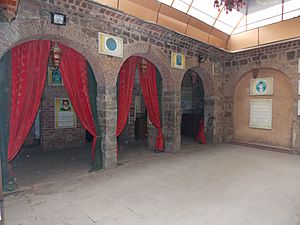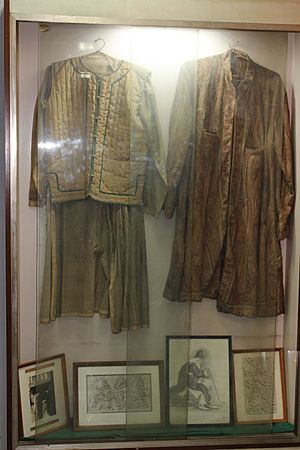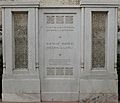Mirza Ghalib facts for kids
Quick facts for kids
Mirza e Noshaan
Dabir ul-Mulk Najam ud-Daula Nizam-e-Jung Mirza Ghalib
|
|
|---|---|
 |
|
| Native name |
مِرزا اسَدُاللہ بیگ خان
|
| Born | Mirza Asadullah Baig Khan 27 December 1797 Darya ganj, Akbarabad, Mughal Empire (now Agra, India) |
| Died | 15 February 1869 (aged 71) Gali Qasim Jaan, Ballimaran, Chandni Chowk, (now Ghalib ki Haveli, Delhi, India) |
| Occupation | Poet |
| Period | Mughal era, British Raj |
| Genre | Ghazal, Qasida, Rubai, Qat'aa ,Marsiyah |
| Subject | Love, Philosophy, Mysticism |
| Parents |
|
Mirza Asadullah Beg Khan ([] Error: {{Lang-xx}}: no text (help)/Persian: مرزا اسد اللہ بیگ خان), known by his pen-name Ghalib ([] Error: {{Lang-xx}}: no text (help)/Persian: غالب), was a very famous Urdu and Persian poet. He lived in the Indian subcontinent during the 1800s. His pen-name Ghalib means dominant, and his earlier pen-name Asad meant lion.
Ghalib was born on December 27, 1796, and passed away on February 15, 1869. He is considered one of the most important and popular poets in the Urdu language. He wrote many ghazals, which are a type of poem. These poems have been sung and interpreted in many different ways over the years.
Contents
Early Life of Mirza Ghalib
Mirza Ghalib was born in 1796 in a city called Akbarabad, which is now known as Agra. His father, Abdullah Beg Khan, and his uncle, Nasrullah Beg Khan, both served in the army.
Sadly, Ghalib became an orphan when he was only five years old. He lived with his uncle for four years, but then his uncle also passed away.
Ghalib started writing poetry, known as sher, while he was still in Agra. He later married the daughter of Nawab Ilahi Baksh 'Maaroof' and moved to Delhi. In Delhi, he focused completely on his poetry. He quickly became very skilled in the Persian language.
Ghalib was very proud of his Persian poetry. However, he is best known today for his amazing Urdu writings, both poems and letters.
Later Life and Challenges
Mirza Ghalib often faced money problems throughout his life. After the year 1857, he lost the financial support he used to get from the royal court. His pension from the British Government was also stopped. This happened because he was thought to have supported the rebels during that time.
He even traveled to Calcutta to try and get his pension back, but it didn't work. Later, the Nawab of Rampur offered him some money. The Nawab said he would give Ghalib 200 Rupees if he lived in Rampur, or 100 Rupees if he lived somewhere else.
Three years later, Ghalib's pension was finally started again. But all that money had to be used to pay off his old debts. Mirza Ghalib died in 1869.
Ghalib's Famous Letters
Mirza Ghalib wasn't just a great poet; he also changed the way people wrote letters in Urdu. Before Ghalib, Urdu letters were very fancy and formal. They used many difficult words and complex styles.
Ghalib made his letters sound like he was actually talking to the reader. He used simple words and sentences, making his letters easy to read and understand. He once said: "sau kos say ba-zabaan-e-qalam baateiN kiya karo aur hijr meiN visaal kay ma-zay liya karo" This means: "From hundreds of miles away, talk with the tongue of the pen and enjoy the joy of meeting even when you are separated."
His letters were very informal. Sometimes, he would just write the person's name and start the letter without any formal greetings. Ghalib himself had a great sense of humor, and he made his letters very interesting and funny. He said: "maiN koshish karta hooN keH koi aisi baat likhooN jo pa-Rhay kHoosh ho jaaye" This means: "I try to write things that whoever reads them will enjoy."
Once, when the third wife of one of his friends passed away, Ghalib wrote something funny about marriage: "Allah allah aik woH log haiN jo teen teen dafaH iss qaid say chhooT chu-kaiN haiN aur aik hum haiN keH aik ag-lay pachas baras say jo phaNsi ka phaNda ga-lay meiN paRha hai to naH phaNda hi TuT-ta hai naH dum hi nikalta hai" This means: "Oh my, there are some people who have been freed from this prison three times, and then there's me, for the past 50 years, this rope around my neck neither breaks nor does it take my life!"
Some experts believe that Ghalib would still be famous in Urdu literature just because of his amazing letters, even if he hadn't written poetry.
Ghalib's Unique Poetry
In Urdu ghazals, which are poems about love and beauty, Ghalib added many other parts of life. Because of him, the topics covered in Urdu ghazals became much wider.
Ghalib was very interested in Persian, so his early poems sometimes used difficult words. His ideas were so imaginative that people would say: "yaa to aap sam-jhay yaa kHuda sam-jhay" This means: "Either you (Ghalib) understand it, or God understands it!"
Even though Ghalib wasn't a philosopher, he often questioned things around him in his poems. For example, he wrote: "jub keH tujh bin nahiN koi maujood phir yeH hungaamaH ai kHuda kya hai" This means: "When there is no one besides you; then, oh God, why is all this commotion?"
You can also find a playful side in his writings. He would often make fun of everything and everyone, including himself. He once wrote: "jiss meiN laakhoN baras ki hooreiN hoN aisi jannat ka kya ka-ray koi" This means: "When the women are millions of years old, what would anyone do with such a paradise?"
Ghalib's poems don't just touch your heart right away; they also make you think deeply.
Google Doodle Honors Ghalib
On December 27, 2017, the search engine Google honored Mirza Ghalib on his 220th birthday. They showed a special picture, called a "doodle," on their Indian home page to celebrate him.
Images for kids
See also
 In Spanish: Mirza Ghalib para niños
In Spanish: Mirza Ghalib para niños















